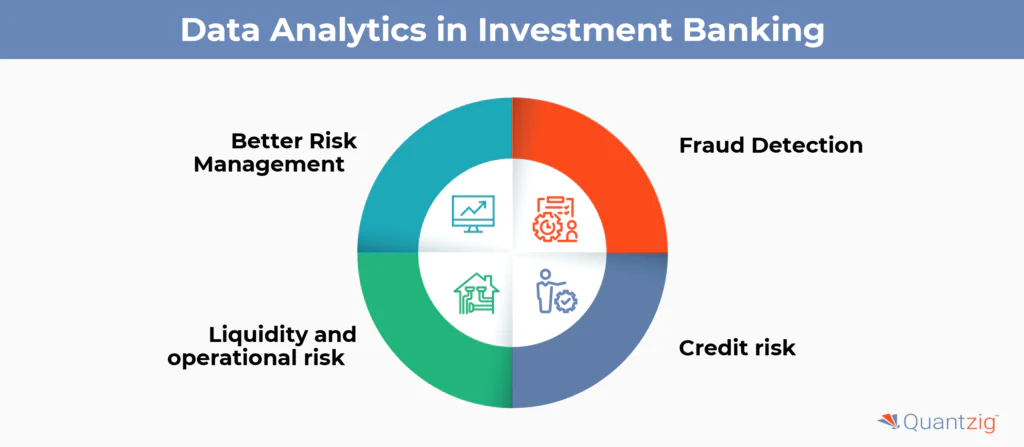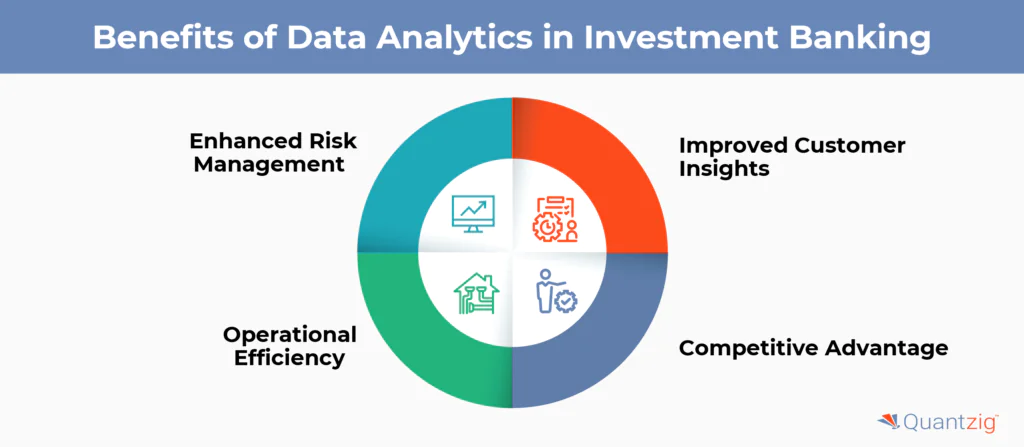Written By: Sudeshna Ghosh
Table of Contents
Introduction to Data Analytics in Investment Banking
The shifts in digitalization have made investment opportunities more widely accessible. There are many ways to invest money, from buying gold and stocks to investing in advanced information technology (IT). The traditional methods of supporting and participating in financial transactions are rapidly transforming due to technological advancements. The main pillars of the world economy are the capital markets. To select the ideal funding options and make the best investment decisions, they bring together experienced economists, IT specialists, and finance professionals. Data analytics is actively used in investment banking to address the significant financial impact of innovations and optimizations.
Let’s talk about use cases, how data analysis in investment banking is changing how investment banks operate, and the difficulties these banks face during this digital transformation process.
Book a demo to experience the meaningful insights we derive from data through our analytical tools and platform capabilities. Schedule a demo today!
Request a Free DemoQuantzig’s Data Analytics Solution for a Renowned Banking Client
| Category | Details |
|---|---|
| Client Details | Our client operates in the renowned investment banking sector. |
| Challenges Faced by the Client | Difficulty in gauging essential metrics such as past performance and current sales performance, challenges in obtaining a holistic view of the sales team’s activities and need for a robust sales strategy to improve product sales and customer experience across platforms. |
| Solutions Offered by Quantzig | Quantzig team provided a robust big data analytics solution to gain deeper insights into customer needs, enabled the client to tailor service offerings, helped categorize end-users and track customers to predict and calculate risks. |
| Impact Delivered | Improved understanding of customer behavior and needs, more effective and personalized service offerings, better risk management through accurate customer tracking, and strengthened customer engagement and loyalty. |
Challenges Faced by the Client
A renowned client in the investment banking sector was facing predicaments in gauging information about essential metrics such as their past performance and current sales performance. Additionally, the investment banking client was facing difficulties in gaining a holistic picture of their sales team’s activities. Consequently, they wanted to devise a robust sales strategy to improve product sales and customer experience across platforms.
Solutions Offered by Quantzig
This robust big data analytics engagement helped the investment banking firm gain more profound insights into the customers, their needs, and buying behavior patterns. The big data analytics solution also enabled them to tailor service offerings accordingly and anticipate future behavioral trends of the customers. This would help the client to categorize end-users accordingly and effectively track customers to calculate and predict risks. The solution offered also helped the client enhance customer engagements and develop long-term relationships.
Impact Delivered
1. Improved understanding of customer behavior and needs.
2. More effective and personalized service offerings.
3. Better risk management through accurate customer tracking.
4. Strengthened customer engagement and loyalty.
Experience the advantages firsthand by testing a customized complimentary pilot designed to address your specific requirements. Pilot studies are non-committal in nature.
Request a Free PilotWhat is Investment Banking?
In the current market scenario, rising cost pressures and changing customer expectations are playing a pivotal role in enhancing customer satisfaction and profitability across all the industry segments. In the investment banking industry space, firms are moving toward a value-based pricing approach to delivering better transparency without compromising the proficiency of their services. Moreover, to enhance customer satisfaction and reduce churn rates, investment banking firms have started leveraging the use of big data analytics to gain more profound insights into the customer data sets. Additionally, with the help of big data analytics, firms operating in the investment banking industry space can create customized products, facilitate effective loss prevention, and improve pricing accuracy.
With years of expertise in providing a wide range of big data analytics solutions, Quantzig helps investment banking firms devise new strategies and strengthen their foothold in the industry space. These solutions also help clients gain profound insights into the customers’ buying patterns and current market trends, which ultimately helps in maximizing the ROI.
Data Analytics in Investment Banking
The application of data analytics in investment banking has resulted in weak returns when compared to previous periods due to a rigid conjuncture. The financial industry and capital markets have experienced a period of revenue stagnation in recent years due to declining margins and an increase in regulatory complexity. Additionally, for the same reasons, the businesses that have historically accounted for a larger share of revenues—fixed income, currencies, and commodities—face a declining essential share.
1. Better Risk Management
Investment banking is the place where numerous resources are heavily invested in risk because the consequences of an inaccurate risk assessment could be devastating. The global economy’s reaction to the financial crisis of 2008 serves as the ideal illustration of this business line’s significant role. Banks use data analysis tools to identify high-default loan scenarios so they can take proactive measures before things spiral out of control to manage these financial crisis risks.
2. Fraud Detection
Reducing fraud is one of investment banks’ common goals. Instead of only detecting fraud, data analytics can be used to recognize patterns of fraudulent transactions or unusual operations, manage potential risk, and notify the right people to investigate the matter further. When identifying and monitoring rating-specific customers who are at risk of fraud, data analytics can be used to apply different levels to those accounts. Investment banks can determine what should be prioritized in their fraud detection efforts by analyzing the risk of the accounts.
3. Liquidity and operational risk
Liquidity risk arises due to insufficient money available. Bad loans, which might never be repaid, or lower-than-expected cash flows—which include lower income or deposits—can be the cause of this. For banks, this is particularly risky because deposits—which are typically paid out net of interest—are the primary source of funding. Operational risk is the possibility of suffering a loss from decisions made by the company. These are potential losses that arise directly from risks related to regular business operations, such as fraud, theft, breaches of computer security, or executive incompetence or error of judgment. Data analytics is used to continuously monitor both short- and long-term liquidity. It also evaluates the effect of transactions on liquidity in real time and conducts frequent stress tests and simulations to ensure that investment banks have the capital they need to operate.
4. Credit risk
Analytics is used by investment banks to help them manage the risk of the loans they make. To do this, they keep an eye on the information they gather about specific clients. The following is possible for this data, though it is not restricted to Client credit rating Usage of credit cards (amount owed) Total debt (amounts owed on all credit cards) Amounts owed (total debt/total credit) on different types of credit.
Analyzing past data to determine a borrower’s creditworthiness or gauge the risk of granting a loan is known as credit risk analysis. where external data from the web, social media, and news is combined with internal data about clients and counterparties to obtain a comprehensive understanding of their financial status and guarantee that risks are adequately addressed. The analysis’s findings will support investment banks in assessing both their own and their clients’ risks.
Key Pillars of Data Analytics in Investment Banking at Global Institutions
1. Responsibility and governing
Describe an operating business model that makes program accountability and governance easier at the corporate level. Policies and standards adapted to the maturity of individual institutions and facilitate close collaboration amongst important stakeholders are necessary to support the model.
2. Improvements to reporting and internal controls
Create a front-to-back control environment that is dependable and long-lasting to minimize operational improvements, lowering the need for end-user computing (EUC) applications, and reducing reporting adjustments throughout the report preparation life cycle.
3. Management of data and quality
Provide strong platforms to handle important data elements, put data quality guidelines into practice, increase data tracing, streamline data lineage, and handle and resolve problems.
4. Data architecture and business
Simplify the architecture while using granular data to comply with regulatory requirements. Additionally, programs aim to incorporate straight-through processing at the data supply chain’s aggregation and origination layers.
Drivers of Big Data Technology Adoption in the Investment Banking Industry
Big data technology is being used by the investment banking sector more and more to stay competitive and adapt to the rapidly changing market conditions. This change is being driven by several important factors, giving investment banks the ability to use data insights and advanced analytics for both operational and strategic decision-making.
1. Enhanced Risk Management
Significant risks that investment banks must deal with include credit risk, market volatility, and regulatory compliance. Big data technology makes it possible to do predictive analytics and risk assessment in real time and risk modeling, which helps banks more efficiently foresee and reduce possible risks. Banks can optimize their risk exposure, identify early warning signals, and adhere to strict regulatory requirements by analyzing massive amounts of data from various sources. In addition to protecting assets, this proactive approach to risk management increases investor confidence.
2. Improved Customer Insights
Investment banks must comprehend consumer behavior and preferences to provide customized services and keep customers. Deep insights into customer interactions, transaction patterns, and investment preferences can be obtained through big data analytics. Banks can improve customer satisfaction and loyalty by customizing their offerings to match the needs of individual customers by utilizing these insights. Advanced analytics can also be used to find high-value customers and new market niches, which helps with targeted advertising and calculated client acquisition.
3. Operational Efficiency
One of the main factors pushing big data technology adoption in investment banking is operational efficiency. Big data solutions simplify several procedures, including compliance and reporting as well as trade execution and settlement. Banks can cut costs and increase accuracy by automating repetitive tasks and streamlining workflows. Furthermore, big data analytics facilitates continuous process improvement by assisting in the identification of inefficiencies and bottlenecks. This increase in efficiency results in quicker decision-making and a more flexible reaction to changes in the market.
4. Competitive Advantage
Big data technology provides a major competitive advantage in the fiercely competitive investment banking market. Banks can gain actionable insights, find hidden patterns and trends, and make well-informed decisions more quickly than their rivals by utilizing big data. Innovation in market positioning, strategic planning, and product development is supported by this data-driven methodology. Investment banks that use big data well can also set themselves apart by providing superior analytics services, which draw in high-end customers and capital.
Big data technology is being adopted by the investment banking sector due to the need for improved customer insights, operational efficiency, competitive advantage, and risk management. Investment banks can better navigate the complexities of the financial markets and provide value to their clients and stakeholders by incorporating advanced analytics into their operations. Adopting big data is a strategic necessity for investment banking that is prepared for the future, not just a technological advancement.
How Big Data Analytics is driving the Financial Revolution?
The rapid growth of technology and data generation is transforming the way industries operate, and the financial services sector is no exception. As a data-intensive sector, finance offers a unique opportunity to process, analyze, and leverage data in meaningful ways.
Traditionally, financial decisions were made by humans based on calculated risks and trends. However, with the advent of big data and machine learning, computers are now capable of making accurate predictions and human-like decisions. This has led to significant advancements in the financial sector, particularly in areas such as:
- Real-time Stock Market Insights: Big data is revolutionizing the stock markets by enabling computers to make accurate predictions and execute trades at rapid speeds. This has resulted in highly optimized insights for traders to maximize their portfolio returns.
- Big Data Analytics in Financial Models: Big data analytics presents an opportunity to improve predictive modeling, enabling more precise predictions and effective risk mitigation. This has significant implications for financial trading and investment decisions.
- Customer Analytics: Financial organizations are leveraging big data to understand customer needs and preferences, anticipate future behaviors, and enhance customer satisfaction. For example, OCBC analyzed historical customer data to design an event-based marketing strategy, resulting in personalized marketing communications across multiple channels.
- Risk Management and Fraud Detection: Big data is used to mitigate operational risk and combat fraud by identifying suspicious activities in real-time. For instance, banks can use real-time data to identify fraudulent transactions and notify cardholders of security threats. Similarly, insurance companies can access data from various sources to flag suspicious claims for further investigation.
The integration of big data and machine learning has also led to significant advancements in fraud detection. For example, Alibaba built a fraud risk monitoring and management system based on real-time big data processing, which identifies bad transactions and captures fraud signals by analyzing user behaviors in real-time.
Overall, big data is transforming the financial sector by enabling more accurate predictions, personalized customer experiences, and effective risk management.
Get started with your complimentary trial today and delve into our platform without any obligations. Explore our wide range of customized, consumption driven analytical solutions services built across the analytical maturity levels.
Start your Free Trial





